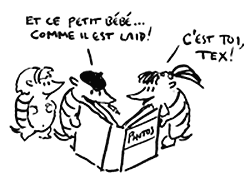Adjectives
Adjectives that precede the noun
The placement of most adjectives in French is after the noun: un escargot parlant, une fourmi travailleuse, des tatous intelligents, etc. There is a small group of adjectives, however, that normally precede the noun. These adjectives may be categorized as adjectives of Beauty, Age, Numbers, Goodness, and Size (BANGS).
| autre | other |
| beau (belle) | beautiful |
| bon (bonne) | good |
| grand (grande) | tall, big |
| gros (grosse) | big, fat |
| jeune | young |
| joli (jolie) | pretty |
| mauvais (mauvaise) | bad |
| nouveau (nouvelle) | new |
| petit (petite) | little |
| vieux (vieille) | old |
ordinal numbers:
| premier | (première), first |
| deuxième | second |
| troisième | third, etc. |

| Tammy est une belle Américaine. C’est aussi une bonne amie. C’est une petite tatou. | Tammy is a beautiful American woman. She is also a good friend. Tammy is a little armadillo. | |
| Trey est le jeune frère de Tex. C’est le troisième enfant de la famille. | Trey is Tex’s young brother. He is the third child in the family. |
beau, nouveau, vieux
Beau, nouveau, and vieux have irregular forms. Note the special forms in the masculine singular when they precede a word that begins with a vowel or a silent h.
| masculine singular |
masculine before vowel |
feminine singular |
masculine plural |
feminine plural |
| beau | bel | belle | beaux | belles |
| nouveau | nouvel | nouvelle | nouveaux | nouvelles |
| vieux | vieil | vieille | vieux | vieilles |
The adjectives which precede the noun must agree in number and gender with the noun they modify (see the regular rule for adjective formation). Be aware that changing the position of some adjectives may change their meaning. Listen to this dialogue:
| Tex et Tammy regardent le nouvel album de famille de Rita. | Tex and Tammy are looking at Rita’s new family album. | |
| Tammy: Qui est cette belle femme? | Tammy: Who is that beautiful woman? | |
| Rita: C’est notre mère. | Rita: That’s our mother. | |
| Tammy: Et qui sont ces autres personnes? | Tammy: And who are these other people? | |
| Rita: Le vieil homme, c’est Paw-Paw Louis. Et puis, à côté, c’est moi. | Rita: The old man, that’s Paw-Paw Louis. And then, next to him, that’s me. | |
| Tex: Et ce petit bébé, qui est-ce? Comme il est laid! | Tex: And the little baby, who is it? Boy is he ugly! | |
| Rita: C’est toi, Tex. C’est la première photo de toi. | Rita: That’s you, Tex. It’s the first picture of you. |


